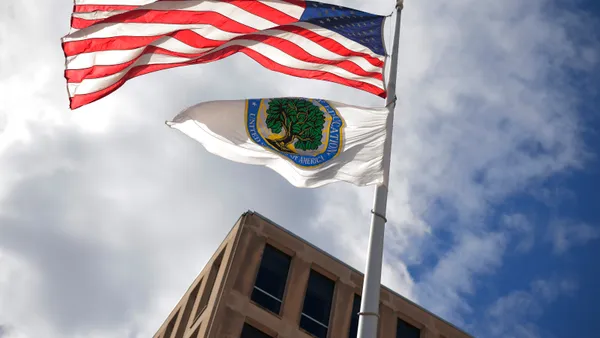From a public relations perspective, accreditation needs to be more than a pass or fail experience, said Ed Klonoski, president of Charter Oak State College, at a panel discussion during the annual Council for Higher Education Accreditation (CHEA) conference last week.
"We need more from the results of accreditation to say what we do well and where we are exemplary and where we are failing," he added. "The results of a 'P' or 'F' are not sufficient."
Simply, the reality is that higher education and its expectations have changed, which means the standards for evaluating an excellent education must also change, said Martin Kurzweil, director of the Educational Transformation Program at research group Ithaka S+R. But, he explained, accrediting agencies and higher education leaders are still trying to figure out what exactly that set of standards should mean.
"The question posed by this panel is, 'What is the new normal for accreditation?' and I don't think we can answer this question without asking 'What is the new normal for higher education,' and higher education has changed quite a bit over the past thirty or forty years," said Kurzweil.
Throughout the concurrent panel discussions, accrediting groups and higher education leaders tackled these questions — and it was clear that both sides were bringing different ideas to the table. There was a consensus among the two sides though on this: there needs to be more communication on what exactly is happening in the world of accreditation to determine how to move forward. So, here we present what both sides had to say.
New standards: necessary for broader guidance
Above all, Klonoski expressed a desire for accrediting agencies to develop a set of standards that go beyond the mere pass or fail system and create a differentiated set of expectations and punishments for schools according to their individual attributes. He took care to note that "arrogance is the enemy" and all institutions should be aware of their flaws in order to improve. However, he also said accreditation needs to change, arguing for the process to be broader, more transparent and singular.
On becoming singular, Klonoski said there are around "six regional accreditors, six national accreditors 78 or so programmatic, four faith-based accreditors," each providing their own standards, which makes it difficult for institutions to follow one set of guidance.
On transparency, he said there needs to be better reporting on what schools are doing well and not doing well; and, on being broader, he explained there are an increasing number of sources of "non-collegiate learning" to parallel the rise in non-traditional adult learners, which need a different type of evaluation from the traditional two- and four-year school.
"Is there a way for us to come together and create a kind of national standard that non-collegiate learning providers can use to guarantee that their outcomes are reasonably high quality?" posited Klonoski. "Can we offer some assurance to learners that money they are spending on education are producing outcomes that meet a standard?"
Coding academies, he said, can claim their standard is employability, so they can get away with giving a number; but, for traditional colleges, employability is not the only goal of education and not the only measure of quality or success.
Kurzweil echoed these sentiments and mentioned the practice of peer benchmarking as a way for accrediting agencies to better create standards across similar institutions.
"I think a standard without reference to other standards that exist within the space is essentially arbitrary. It needs that context in order to make sure the provider is setting goals that are ambitious, but attainable. And the only way to do that is to look at what other are doing," he said. "Though peer benchmarking can easily tip into rankings. I don't think that's the direction that I would want to go. I think an appropriate technique is to consider the historical results for a set of similar providers and use that to create a standard that is an objective standard," he explained.
Though, Klonoski noted this process of coming up with a peer review system should still rest on the shoulders of accrediting groups.
Accrediting agencies: doing more than you think
At a concurrent session, Neil Harvison, chief officer of professional affairs at American Occupational Therapy Association, said there are some areas that accrediting agencies deserve a bit of criticism.
"Criticism that there is a lack of consistency in language and terminology across the processes of accreditors and is confusing to the stakeholders — I would have to agree with that," said Harvison. "Tying into that is the issue of communication across the different accrediting groups."
However, he explained that accrediting groups are often wrongly criticized in multiple areas. One common stereotype, he said, is that higher education stakeholders often say its not fair for accrediting agencies to only check in every 10 years. Mary Ellen Petrisko, past president of accrediting group Western Association of Schools and Colleges Senior College and University Commission (WSCUC), agreed.
"We have tried to agree to some definitions are the same, but we have found that it is easier for us to adopt new things that are coming into the field and agree with them, rather than try to dial back over 100 years of practice and language," she explained. But like Harvison, she said accrediting agencies are trying to do a lot to improve the industry.
"I know in our case we do consistent reporting. There are follow ups, follow up visits that are done on the basis of those respective institutions' compliance standards. And we have been clear about those results. But still, groups come back to the same criticisms that are simply not true," she said.
Harvison also notes that accrediting groups have to serve a difficult and dual function of providing quality assurance and acting as a gatekeeper in the industry. While education stakeholders, like Klonoski ask for perhaps a national standard, Harvison questions whether it's a good idea for there to be one overarching group.
"Yes, that does raise some conflicts. It raises the stakes. If I withdraw accreditation from a program, it could mean my students are getting a degree that is absolutely worthless in our society," he said. "But is that conflict insurmountable? If we give it to the states or federal departments, that raises a number a bunch of issues. Do we want them judging practices?"
The middle ground: better communication and collaboration
In terms of the "new" accreditation model, Petrisko says first and foremost, there needs to be more communication across industry stakeholders and accrediting agencies about what is actually going on.
"We have heard a lot of complaints about transparency, but we do make sure we are putting up not just the self studies, but the team reports with action items in newsletters on our site since 2012," she said. "I have looked at the analytics to see who is actually looking at commission action letters. As you can imagine people don't look at the full reports, just the letters. But it's all out there."
One aspect of reports Kurzweil said would serve as a middle ground then is for accrediting agencies to additionally include peer reviews from the providers, so fellow institutions could get an idea of what their specific industry standard is.
"Providers need to make reference to peer practices and peer outcomes in describing their own claims, goals and outcomes and that would encourage them to form relationships with peers that would allow them to do that and they would have that mutual perspective," he said.
Harvison offered a caveat to the reporting process though in saying that while it's true transparency is important and consistency in standards is key, it's also important for industry stakeholders to recognize that students' decisions to enroll in an institution go beyond just the data — and that's something accrediting agencies are constantly dealing with when trying to determine best set of evaluation practices, which means that many groups have actually developed those differentiated standards Klonoski and Kurzweil mentioned.
"Even if you put outcomes, there are a number of other reasons why people chose to go to school, like geographic location [...] Just putting the data on the computer isn't necessarily going to solve the issues of student ROI," said Harvison. With this, Petrisko concluded by saying the disconnect shows there needs to be more collaboration across accrediting agencies, policymakers and institutions to determine what kinds of qualities are important to measure, as well as what is necessary to measure.
"On measuring data, it's important to measure not what is easily measurable, but what really counts," Petrisko said. "And, we as accreditors need to ... say this is how successful we are on what we are doing, or else people will continue to criticize and we cannot come back with real information [for the stakeholders]."











